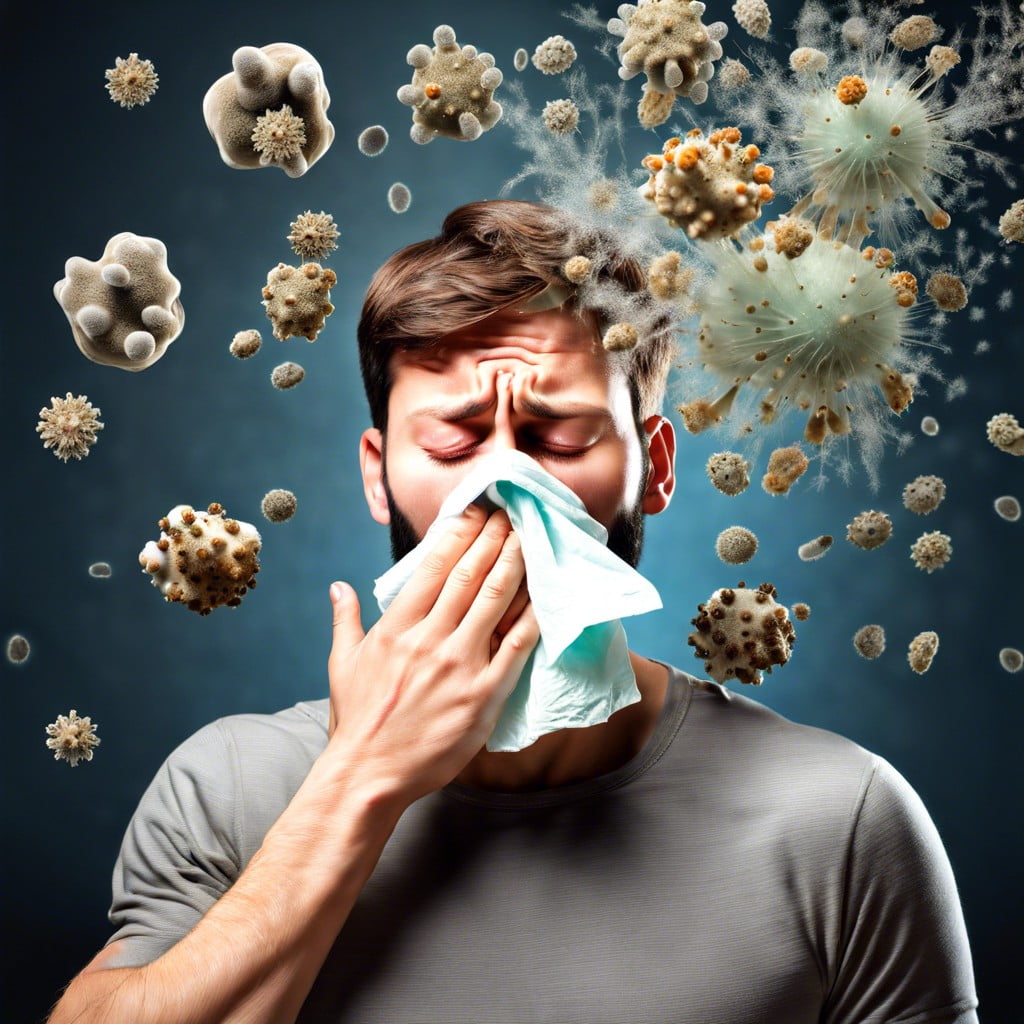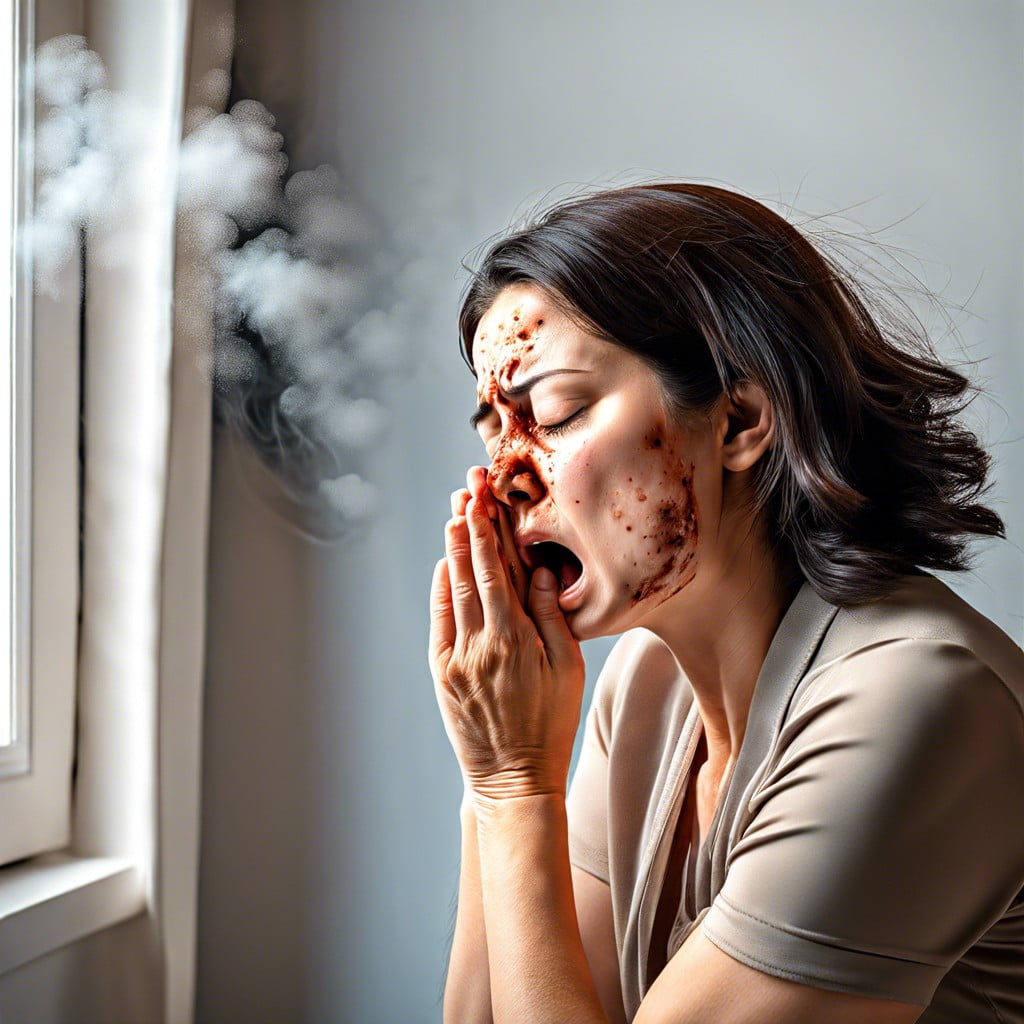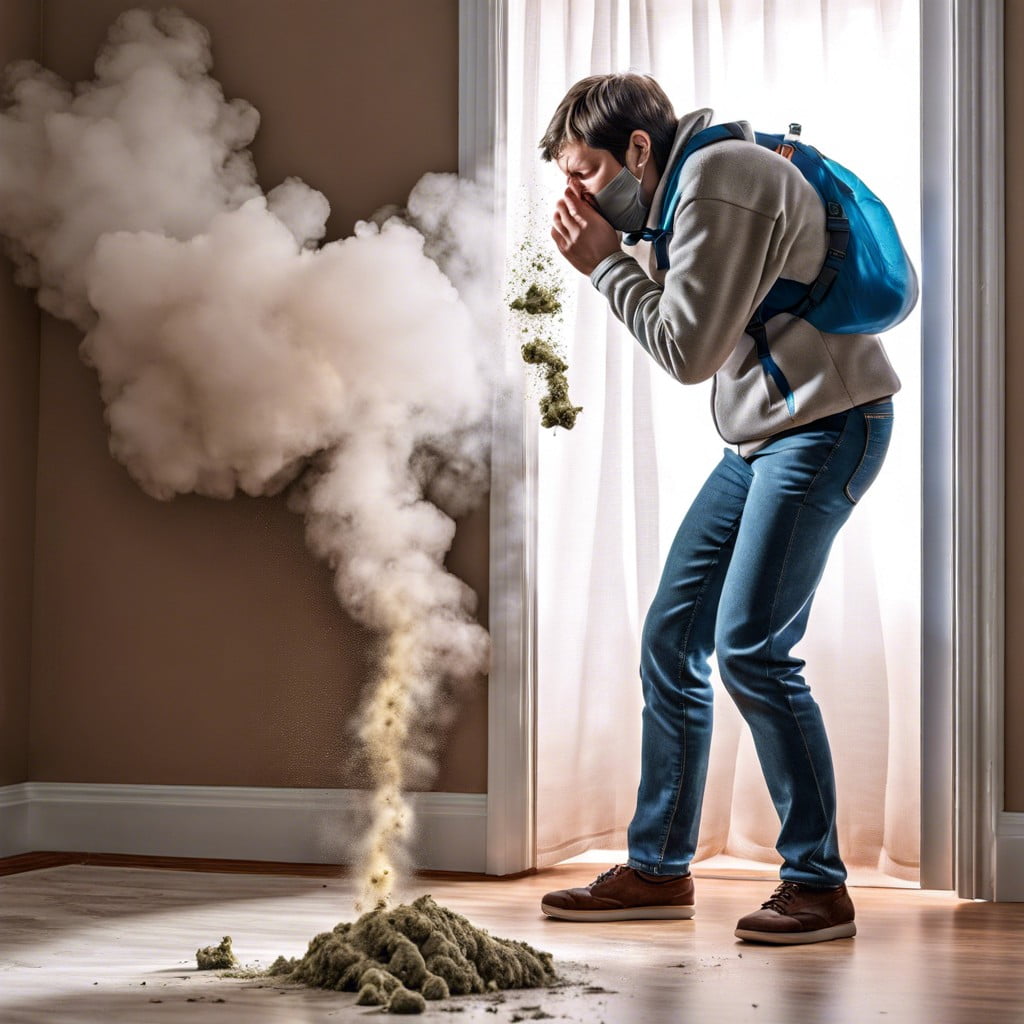Last updated on
Recognizing mold toxicity is crucial because it can stealthily affect your health and home.
Are you battling unexplained allergic reactions, feeling perpetually worn out, or experiencing bothersome respiratory problems? It’s possible that your health symptoms are not just random occurrences but warning signs of mold toxicity – a condition often overlooked yet potentially serious.
Joint pain that mimics arthritis, unexplained cognitive difficulties like memory lapses, and consistent mood swings could point to an invisible invader in your environment: mold.
Understanding these 10 critical warning signs can be the key to uncovering a hidden mold issue and may be pivotal in regaining your health.
Dive into our detailed discussion to connect the dots between your symptoms and mold exposure, and discover the important steps to address this stealthy health adversary.
Key takeaways:
- Allergic Reactions: Sneezing, runny nose, itchy eyes, throat discomfort.
- Persistent Fatigue: Evaluate sleep quality, track energy levels.
- Respiratory Issues: Difficulty breathing, coughing, wheezing, shortness of breath.
- Joint Pain and Stiffness: Rheumatoid arthritis-like symptoms, random joint impact.
- Cognitive Disorders: Difficulty concentrating, memory problems, mood swings.
Allergic Reactions

Exposure to mold often triggers a range of allergic reactions reminiscent of seasonal allergies. These can include sneezing, runny or stuffed nose, itchy eyes, and throat discomfort.
Regularly encountering such symptoms in the absence of pollen or known allergens should prompt an assessment of your living environment for mold presence. Keep an eye out for a pattern in these reactions, especially if symptoms alleviate when away from the affected area, indicating a likely mold issue at home or work.
Additionally, people with pre-existing allergies or asthma may notice a worsening of their symptoms, which is a clear signal not to overlook. Addressing mold early helps mitigate these allergic responses and protect your health.
Persistent Fatigue

If you’re constantly feeling tired despite getting a full night’s sleep, this may be a red flag. Mold exposure can disrupt your sleep cycle and lead to chronic fatigue. It’s essential to note that mold doesn’t necessarily have to be visible; airborne spores can still affect your health.
Here’s what to keep in mind:
- Evaluate your sleep quality. Even if you’re in bed for eight hours, mold toxins can prevent deep, restorative sleep.
- Keep track of your energy levels throughout the day. Do they dip in certain environments, like your home or office? This could suggest mold presence.
- Consider if your fatigue improves when spending extended time away from suspected mold-infested areas.
- Pay attention to other symptoms that might accompany the fatigue, such as difficulty concentrating or minor aches, which often go hand-in-hand with mold-related health issues.
Respiratory Issues

Mold spores can invade and irritate the lining of your airways, leading to troubling symptoms. If you find it difficult to breathe, experience fits of coughing, or notice wheezing and shortness of breath, these could be red flags indicating mold’s impact on your respiratory health.
Someone with asthma may notice an increase in attacks, which should not be brushed off. It’s important to consider these symptoms seriously, especially if you notice a connection between your respiratory discomfort and time spent in certain environments. Clean air is vital, so these signs are your body’s way of signaling that something may be amiss, possibly mold hiding in your midst.
Joint Pain and Stiffness

Experiencing an unexplained increase in joint pain and stiffness could be a red flag for mold exposure. When mold spores are inhaled, the immune system may respond with inflammation throughout the body, including in the joints. This reaction is your body’s defense mechanism against what it perceives as a threat.
Here are a few points to consider:
- The discomfort might mimic rheumatoid arthritis, presenting as aching, throbbing, or swelling in the joints.
- Unlike typical joint conditions which affect specific areas, mold-induced symptoms often appear randomly and can impact multiple joints.
- Typically, these symptoms may not respond well to standard treatments for joint issues, which can be a clue that an environmental factor like mold is the cause.
Taking note of when and where these symptoms occur can help trace them back to possible mold exposure. If joint issues persist and you suspect mold, a consultation with a healthcare professional is advisable. It’s equally important to inspect your living space for mold hotspots as part of a proactive approach to maintaining your health.
Cognitive Disorders
Mold exposure can lead to a troubling array of mental fog and memory issues, often overlooked or misdiagnosed. The toxins produced by certain molds have neurotoxic effects, which can disrupt brain function and lead to:
- Difficulty concentrating: You may find it harder to focus on tasks or suffer from a shorter attention span.
- Memory problems: Forgetting appointments or misplacing items could become more frequent.
- Confusion: Regular tasks might seem more complicated, or you could get disoriented easily.
- Mood swings: Unexplained changes in mood or sudden bouts of irritability can occur.
These symptoms can disrupt daily life and are important indicators that your environment should be evaluated for mold. If cognitive symptoms persist, consult with a healthcare professional for assessment and testing.
Skin Irritation
If you find yourself scratching an unexplained rash or battling bouts of red, inflamed skin, mold exposure might be the culprit. Close encounters with mold can trigger an immune response, leading to itchiness and even hives. This is because mold releases substances that can irritate the skin directly or incite an allergic reaction.
To soothe affected skin, start with gentle, hypoallergenic cleansers and moisturizers. Antihistamines may alleviate symptoms. However, if over-the-counter remedies aren’t helping, seek medical advice – a healthcare professional can prescribe stronger treatments and confirm whether mold is the true instigator.
Preventing future flare-ups hinges on tackling mold at its source. Regularly check your living spaces for signs of mold, especially in damp areas. Quick action, including professional mold remediation if necessary, can help maintain your skin’s health and your overall well-being.
Chronic Sinus Issues
A telltale sign that mold may be impacting your health is a seemingly endless cycle of sinus infections or congestion. Here’s why:
- Mold spores can irritate the sensitive linings of your nasal passages.
- The immune system responds to this invasion by producing mucus, leading to congestion.
- If you’re frequently battling sinus pressure or discomfort, consider evaluating your indoor air quality.
- Exposure can also exacerbate existing conditions, like chronic rhinosinusitis, amplifying symptoms and discomfort.
To counteract these issues, regularly inspect areas prone to dampness in your home and consider a high-efficiency particulate air (HEPA) filter to reduce airborne spores.
Gastrointestinal Disorders
Exposure to mold doesn’t just affect your respiratory system, it can also have a significant impact on your digestive health. When mold spores are ingested, they can irritate the lining of your stomach and intestines, leading to discomfort and disruptions in digestion.
Here are a few signs that mold may be impacting your gastrointestinal system:
- Nausea and Vomiting: An immediate and sometimes violent reaction to mold toxins, indicating your body’s attempt to expel the irritants.
- Diarrhea: Frequent, loose, or watery stools may signal that your body is trying to rid itself of harmful substances like mold spores.
- Abdominal Pain: Cramping or a persistent ache in your stomach area may develop as a response to mold-related irritation.
- Appetite Changes: A decrease in appetite can occur if your body is fighting off the effects of mold toxicity.
If you’re experiencing any of these symptoms, consider inspecting your environment for signs of mold, especially in damp areas like basements, bathrooms, and kitchens. Removal of any detected mold may alleviate these distressing gastrointestinal symptoms.
Headaches & Migraines
Exposure to mold can trigger frequent and unexplained headaches or even migraines. This is a result of the body’s reaction to mycotoxins — toxic substances produced by mold. If you find yourself reaching for pain relief more often, especially after spending time in certain areas of your home or office, consider investigating for mold.
Not all headaches are caused by mold toxicity, but it’s important to rule it out, especially if other warning signs are present. Ensure proper ventilation and address any water leaks promptly to minimize the risk of mold growth. If headaches persist, consulting a healthcare professional is advisable.
Preventing Mold Growth in Your Environment
Keep indoor humidity levels in check, ideally between 30-50%, using dehumidifiers and air conditioners. Regularly ventilate areas prone to moisture, like bathrooms and kitchens, by opening windows or installing exhaust fans.
Fix leaks swiftly to prevent water accumulation, which mold thrives on. Store food properly and dispose of it before it spoils. Use mold-resistant products for home renovation, such as paint and building materials.
Clean and dry any damp spots within 24 to 48 hours to inhibit mold growth. When cleaning mold patches, wear protective gear and consider professional help for large areas. Regularly inspect household plants, as they can harbor mold in their soil.
Incorporate these practices into your routine for a mold-resistant living space.
FAQ
How do you know if mold is making you sick?
Symptoms such as coughing, itchy eyes, restricted breathing and other airway issues may indicate that you are being made sick by mold exposure, particularly if you have asthma or a mold allergy.
What are the neurological symptoms of mold exposure?
Mold exposure can lead to neurological symptoms such as headaches, cognitive impairments, memory loss, impaired motor skills, and mood changes, particularly in individuals with weakened immune systems.
What kills mold in your gut?
Mold in the gut can be effectively dealt with through the use of mold binders such as prescription binders, activated charcoal, or bentonite clay.
What does mold detox feel like?
Mold detox can result in predominantly flu-like symptoms including fever, upset stomach, stuffy nose, and widespread body aches.
Can exposure to mold cause skin problems?
Yes, exposure to mold can cause skin problems such as rashes, itching, and redness.
What is the connection between mold and respiratory issues?
Exposure to mold can lead to respiratory issues such as coughing, wheezing, and asthma due to the allergens and irritants that molds produce.
How does mold exposure affect the immune system?
Mold exposure can negatively impact the immune system by triggering allergic reactions, provoking immune disorders, and making individuals prone to respiratory infections.
Recap




